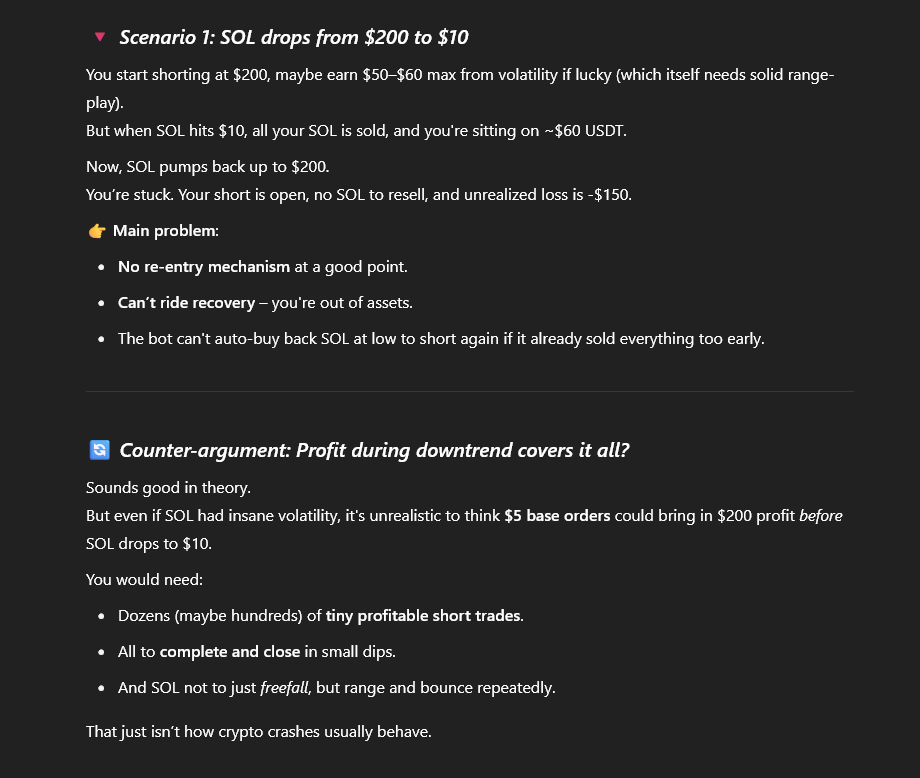After nearly two years running a hedge strategy, I’ve decided to go shorts-only. There’s been a lot of debate around shorts, so I want to share why I made the switch—and how I see it after being on both sides. Please note that the following concerns shorting in spot, futures shorting is a completely different game and don’t follow the same principles I am about to share.
The Debate: Portfolio Value vs. Passive Income
There are two camps when it comes to shorting:
- “Short profits aren’t real profits” — When a short closes in profit, it’s because the token went down, so your portfolio value is down.
- “Portfolio value is irrelevant” — What matters is generating income over time. The value of the portfolio will fluctuate, but long-term compounding wins.
Which side you’re on depends on your goals. If you track success by portfolio value, shorts might seem counterproductive. If you’re after income generation, shorting can be a valid strategy. However, it’s important to notice that both views are valid, so much of the discussion we had over the months is because one side failed to appreciate the other.
I’ve flipped between both sides over the years—even before starting Gainium. I get the logic behind #2. It reminds me of running a business: you invest up front, and eventually the income stream builds wealth. Yes, your business itself might gain value (and you can sell it as such), but what really matters is the cash it produces.
That’s how I now approach shorts. It’s not about chasing upswings. It’s about building steady income with a long-term mindset. It’s less about trading. It’s more like operating a cashflow machine.
Misconceptions About Shorts
Let’s clear one thing up: you’re not making money when the short closes. You already made it when the short was opened.
Here’s what I mean:
- Say you hold 1 token worth $100.
- You short it with a 10% take-profit (TP).
- That means you sell the token for $100 and place a buy order at $90.
- Your account now holds $100 and a pending buy at $90. The $10 difference is “locked” profit—if the market fills the buy order, you end up with your original token plus $10.
Now, if you manually close the short early at 5% profit (buying at $95), you’ve effectively given back $5 of that $10 expected gain. So your available USD is real only if you stick to your plan and let the short finish. Otherwise, it’s partial.
Why I Prefer Shorts Now
The main reason I switched: peace of mind.
When prices drop, shorts bring calm. Longs don’t. On spot, both longs and shorts only grow your portfolio when prices go up. But the way they handle price drops is different:
- Longs close in profit, then keep buying higher—fine during a rally, but terrible in a downtrend.
- Shorts show an unrealized loss on the way up, but this loss is just the cost of not having sold higher. It’s not real unless you close the position under the average acquisition price.
When shorts close, you get back your token plus a bit of USD. That feels better to me. If the price drops, I’m not holding a bag—I’m re-acquiring my asset, with extra cash. If it rises, I see unrealized losses, but that’s just numbers unless I act on them.
A Few Caveats
Shorts aren’t magic.
- They still need the price to go down to function. If it only goes up, your bot may stall (though, depending on your average price, perhaps you are in profit already).
- If you sell under average price, your math gets messy. You’re likely locking in losses, and lower prices reduce the token’s ability to generate future profits.
- I personally don’t touch profits from shorts until there’s a deep price drop. Then I use those profits to refill the base.
Also: stick with liquid, higher-cap tokens. If one low-cap coin crashes hard, it can wipe out months of careful profits.
Final Thoughts
This approach won’t be for everyone. It’s for traders focused on long-term income who understand the mechanics of shorting deeply. If you’re more concerned with portfolio value in the short term, you might find it uncomfortable.
But if you’re like me, and think of your strategy like a business—not a bet—shorts might just give you the control you’re looking for.
